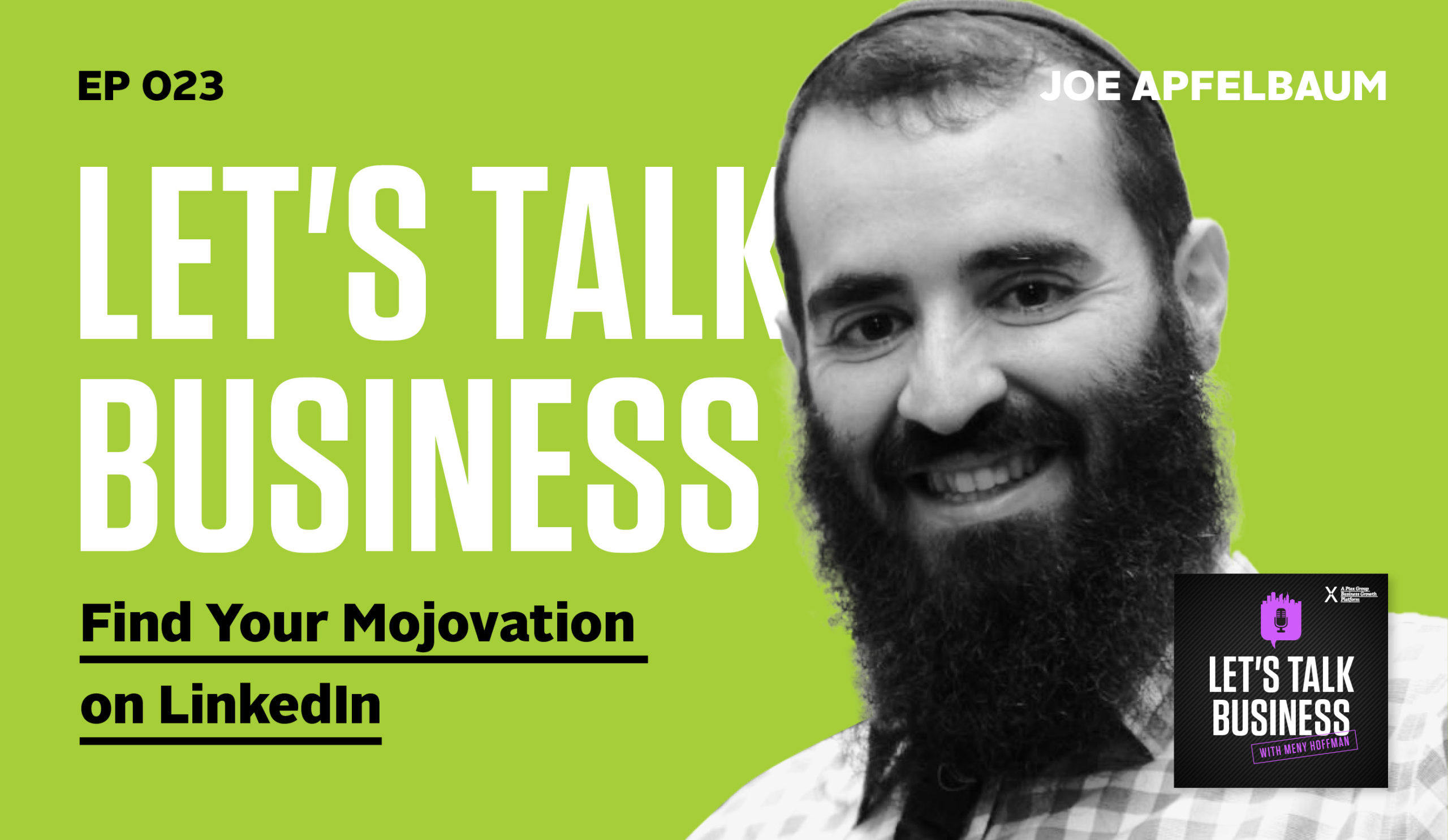Adam Lean, Partner at The CFO Project, spills some tips and tricks on how business owners can make more money in less time with less stress.
We’ve all seen great companies suddenly fold because they didn’t grasp how to track their financials to achieve success. Do you know how to analyze your numbers for strategic growth? Sadly, most business owners think they do, but they don’t.
That’s why I am excited to share my interview with Adam Lean. Adam is an accountant and multimillion-dollar business owner for many years. His passion is helping business owners grow and scale, and Adam is a partner at The CFO Project, an organization that provides small businesses with affordable access to CFOs (Chief Financial Officer) to guide them, to make sense of all the numbers and to give them a clear plan of action for their business goals.
In this interview, Adam and I discussed the critical skill of interpreting financial data to navigate your company’s future. He explains the difference between an accountant, controller, CFO, and bookkeeper, and when to use each of these resources for your business. Pay close attention to Adam’s practical seven-step process for tracking your numbers to see where you are now in your business and how to achieve your dreams.
There are so many golden nuggets in this episode that I know you will enjoy it. Without further ado, here is my interview.
Listen to the podcast here:
Download the audio file here.
Make More Money In Less Time, With Less Stress—with Adam Lean
Adam, thank you for joining me on the show.
I’m excited to be here. Thanks for having me.
We are going to have some fun because when we speak about accounting, usually it’s boring, but with entrepreneurs in this day and age, people love numbers, so we’re going to make it exciting. Before we start, I want you to share with our audience, you have launched and devoted yourself to The CFO Project. Explain to our audience a little bit more about what the CFO Project is all about.
In The CFO Project, the CFO stands for Chief Financial Officer. Numbers are confusing, finance, and accounting. The problem is that accountants and bookkeepers make it confusing for most business owners and entrepreneurs. The bookkeeper will do their job every month and then hand the business owner some reports like the income statement or the balance sheet. Those things are confusing. Conceptually, most business owners understand what those reports are telling you, but not really. Can you look at those reports and honestly know the health of your business? It’s hard to say. Do you know what to do to improve the business or how to make more money by looking at those reports? For the average business owner, the answer is no.
They would get their income statement for the month. They look at revenue and profit. If those numbers are up, then they’re thinking, “It’s great,” but they’re not sure how they got those numbers up. If those numbers are down, they’re depressed, but they’re still not sure how they arrived at those numbers. Much less, they don’t know what to do now to make next month’s performance better in their business. The problem is that the accountants and bookkeepers, because they’re numbers people, produce reports like the income statement, the balance sheet, those are all reports that are made for accountants. They’re not made for business owners. Also, accountants and bookkeepers are needed. You have to have people like that in your business because of what they do well.
What they do is record what happened in the past correctly. They record your numbers correctly so that the IRS is happy so that you have accurate books that you can rely on. They’re vitally needed. However, most accountants and bookkeepers are not trained to help the business owner know what to do in the future to make more money. That’s not what they’re getting paid for. Primarily, an accountant’s job is to be compliance-oriented. They make sure that things are compliant according to tax law and all these other accounting principles. They make sure that your books are correct and accurate. That’s what they’re good at. They’re not getting paid to help business owners know how to improve the profitability in their business and to make more money to have a larger bank account. Who is? The answer is that’s what a CFO, a Chief Financial Officer’s job is.
That’s why every big business has a CFO. Apple, Microsoft and Amazon all have CFOs. They all have millions of dollars in the bank, but they all have CFOs to help the leadership team know how to continue growing and make more money. Big businesses have CFOs because they need them. Regardless if you’re Microsoft or if you own a small restaurant, every business needs somebody like a CFO. You need somebody that can do what a CFO does for big businesses, but you can’t afford a CFO. You can’t afford a $150,000, $200,000 salary if you’re running a small business, but you still need somebody. That’s what we do. We’ve created a way to give small to medium-sized business owners the same benefit of having a CFO without the high price tag. That’s why we call it The CFO Project.
[bctt tweet=”Business owners are not focused on numbers but on the things that they are great at.” username=””]
This topic is important for every business owner like me. I’m a business owner and this is a never-ending topic. The reason is you could speak to many business owners and they’ll be excited by the next shiny object. They’re going to be excited about the next client. They’re going to be excited about the new service, but whenever you start touching numbers, they get all frustrated. At the end of the day as a business owner, you need to have the finger on the pulse. You need to know where the number is. It reminded me of a story I heard from someone. He told me that he worked so hard, a full year in his business and he was successful in growing.
The accountant did his taxes a few months into the next year. He had to sit down with his accountant at that time going through the numbers. Only then did he found out that he miscalculated his margins. He told me that, “If only I would know those months in the year, somebody giving me that information proactively, I could have changed that in a second. I somehow miscalculated the way our salespeople were marking up our projects.” Some of those things are not something that an entrepreneur loves or likes doing, or even looking at reports or even knows what the reports are telling them. It’s important because you’re putting in so much effort in your business, your heart, soul, blood, sweat and tears. At the end of the day, you want to turn a profit.
In order to turn a profit, you need to know your financials to know what’s happening in your market. I feel that many other readers, they’ll want to learn that nonsense advice to figure out some stuff. I want to start with a basic question, which is a business owner running their day-to-day operation. In order to keep the finger on the pulse, what are the different metrics that they do need to understand is the most important metrics that a business owner needs to look at?
That is a great question but let me back up to comment on what you said. The reason why business owners struggle when it comes to numbers is that most business owners get into business in the first place because they love what the business does or they’re trained in it or they’re good at it. For example, a dentist buys a dental practice because they’re a dentist. Somebody that does graphic design and loves graphic design starts a graphic design business because they are an expert at that craft. Somebody that loves to cook or has deep experience in the restaurant industry buys a restaurant because that’s their industry. People get into business because they love what they do.
They don’t get into a business usually because they are expert business numbers person that all they care about is the bottom line. Therefore, most business owners spend their time, their day working on the things that they enjoy doing. Let’s face it, most people don’t enjoy looking at numbers. That’s why they don’t look at it and it’s confusing. The accountants don’t help. They don’t explain things on a level that business owners understand because accountants only speak accounting language and not business management language.
Going back to your question, because business owners are not focused on numbers and focus on the things that they are great at and what keeps the business moving, we need to keep the numbers simple. There’s a handful of numbers that a business owner needs to pay attention to, but all those handfuls of numbers all add up to one thing. This number is more important than any number in the business and that is cashflow. Is the business generating more cash than it spends? That’s why it’s called cashflow. Is more money flowing into your bank than flowing out? That’s the number one thing that matters in a business, not revenue or profit. A lot of people will focus on revenue.
I had a conversation with somebody who wanted to grow revenue by almost $1 million over the next three years. It is great and all, but that’s all he was focused on. Are you okay with growing revenue if your profit or your cashflow is bad or even in the negative? Of course, not. You can’t focus on revenue. It’s the same with profit. You can make $1 million of profit, but if you can’t turn that profit into cash, then what’s the point? There’s no point in making $1 million and having a seven-figure business and only making and keeping $1,000.
Robert Kiyosaki wrote Rich Dad Poor Dad. One of my favorite quotes in that book is, “It’s not what you make that matter. It is what you keep.” Revenue is the making part, cash in the bank is the keeping part. That’s the number one number that matters more than anything. Once you have that cash in the bank at positive cashflow, then you’re in control and you have the power to do what you want to do. You can pour all that money back into the business by expanding it, doing more marketing, hiring more people, buy more buildings or getting more inventory. You can use it to pay off debt or you can give it all to charity. It doesn’t matter because it’s yours, but that’s the number one metric. There’s a handful of numbers that all add up to that one key number, which is cashflow.
You mentioned cashflow and we always joke about it in any business. The bottom line is, what does our P&L tell us? You can’t take the P&L to the bank. You could, but for a loan. Ultimately, payroll is covered with cashflow and the new expansion is covered with cashflow. It’s important how you started off that it all flows to that number, but we want to know what are the metrics that are leading up to that?

The first metric that leads up to cashflow is the number of leads. This is how well your business is doing at marketing. How many leads is your marketing attracting on a regular basis? The second metric to know is your conversion rate. What percentage of those leads are you converting to an actual client? This is a measure of your sales efforts. If you have a sales team, this is how good they’re performing. Assuming you’re getting qualified leads, how well are they converting those leads into clients? The third metric is your retention rate. How many past customers that you’ve successfully sold something to over the past several years, how many of those clients can you retain to come back this year?
The number four is your purchase frequency rate. Once you have a customer that buys this year, how many times can you get them to buy in a twelve-month period? How many purchases can they buy during a twelve-month period? That’s their purchase frequency. The number five is your average purchase. We get a customer to buy this year, whether they’re a new customer or you’ve retained them. You get them to buy multiple times, then that fifth number is every time they buy, what is their average purchase? Can you get that number up? Those are the 5 numbers out of 7 that will add up to cashflow. Those five numbers all help you get more revenue.
This will be helpful for our audience. Even if this is all about accounting, here is where you start to differentiate what a CFO does versus an accountant. An accountant looks at the dollars and cents versus if you want to build up your cashflow, you want to start as a business owner to track stuff. It’s going to be a combination of your marketing, sales and operations effort, and then ultimately how much your clients are buying from you on an ongoing basis to understand what the average purchase is. It’s not just accounting numbers. It’s a set of numbers that you track ongoing that leads you into that final number.
I’ll give our readers a little bit of a deeper understanding and for those who are reading frequently the blog. We operate under the EOS system. One of the things that the EOS system requires is to have a scorecard. Those are the set of numbers that you track on a weekly basis. Numbers like leads, conversions, retention and those purchasing habits on the average purchasing amounts would be stuff that you track weekly. It’s not like you have to look at the end of the quarter and the end of the year how we did, it’s rather, how are we doing? That’s how you make sure that you’re in the now versus you’re in the past.
We could create a scoreboard for our clients to do exactly that because you have to know what to do to make more money in the future. You hit the nail on the head. Those five numbers all add up to revenue, but your accountant or bookkeeper, when they give you your income statement, the very first line is revenue. It doesn’t track all those other numbers. That’s why it’s confusing. You look at your revenue for last month and you’re not sure what happened. If your revenue was down, you’re depressed, but you’re not sure how. Most people, what they do is, “I need to spend more money on marketing and get more leads.”
What if you don’t have a lead problem? What if you’re getting plenty of leads, maybe you have a sales conversion problem? Your sales team is not converting at a good enough rate. That same thing happened to a client. They own a large roofing company. They were getting plenty of leads. They were spending a lot of money on Google Ads. They even had a billboard at a baseball stadium, but once we started tracking these numbers, it became apparent that their sales team was not converting those leads into clients. They didn’t know that. They were spending more money on Google Ads, Facebook networking and all this other stuff to get more leads. You’ve got to track the numbers that all add up to revenue.
I always say that knowing the problem is half of the solution. If you could pinpoint where in the funnel or the different metrics the issue is then you could go ahead and start fixing it versus thinking it’s not working and not knowing what.
Those are the first five numbers that all add up to cashflow. The sixth number is your gross profit. This is the sixth number that you want to improve. A gross profit is a revenue minus all the costs of providing the product or the service. For example, if you own a pizza restaurant, you sell a pizza for $10 and it costs you $4 to make the pizza, the dough, the pepperoni and all that. That means you’re making $6 on the pizza and that’s called gross profit. How can you get that number up? I like to measure gross profit only as a percentage of sales instead of a number.
In other words, I want to know that I’m making 60% on this pizza instead of simply $6 on this pizza because I want to get that 60% up. I can either raise my prices or I can get better costs from my suppliers. If I’ve used a cheese supplier for years and they steadily have gone up on prices, can I shop around to other cheese suppliers and get a better rate? That adds up to gross profit. The seventh number is your net profit. Once you make a gross profit, you’ve got to pay all your overhead and that leaves you your net profit.
[bctt tweet=”The best business metric you should benchmark against is yourself.” username=””]
Are there any industry standards when we speak about net profit, as far as what margins the person should be aiming for? Is this depending on the industry, but is there anything that you could share, like what a healthy business looks like?
There are industry standards for most industries. You could check it with your industry association. Most industries publish that. You can even google for your industry what a healthy margin is. Here’s the problem though, a lot of them are wildly inaccurate. If I’m going to go back to the pizza restaurant example. There’s a target margin for the pizza industry, but that varies depending on if you’re in New York versus LA versus a small town in Ohio. It also varies on the size of your restaurant. If you’re doing $1 million versus $75,000 versus $10,000 versus $10 million a year in revenue. All of that is going to skew the industry averages. I think you should look at that and get a good gauge. However, the best metric you should benchmark against is yourself. You need to take what you did last year in net profit and see if you can beat it this year. If you made a 10% net profit, can you do 11% this year?
This is great advice. I know that in our company, we push ourselves with our operations team and incentivize operation teams if we are able to bring up the profit margins by service. That means delivering the same value, the same quality, but ultimately tightening the margins so at the end of the day, there’s more profit at the end.
That’s great. Getting your team involved because they impact your margins, especially overhead. Expenses are one of those things that most people naturally think, “I had low profit,” or “I even had a loss. I need to cut expenses, cut payroll, cut marketing,” or whatever. Sometimes that’s prudent, but usually, that’s not prudent because the whole point of an expense is to spend money to help you make money. In other words, if you’re going to spend money, you need to ensure the money that you’re spending. Let’s say on marketing, if you spend $1,000 on marketing, you want to make sure you’re getting at least $1,001 back in the form of profit. Otherwise, why spend the money?
It is the same with payroll. If you’re going to spend the money, you need to make sure you’re getting a return on that money. That’s why also simply cutting expenses is not good advice. It’s like cutting off your nose, despite your face. As long as the expense is making you money, why cut it? You want to make sure you’re making money on that expense and if you are, double down. If I knew that for every $1 that I put in a box, I got $10 out, I’d put more $1 in that box all day long.
There’s an old saying in marketing, “Fifty percent of the marketing works, the problem is we don’t know which 50% is not working.” Let’s turn the conversation into the concept to small business owners. The typical small business owner starts off one-man operation and grows to a team of 2, 4, 10, 50, 100 or whatever they grow. Slowly but surely, they’re filling in different positions. Probably the first person doing finances is a typical data entry and then moves into bookkeeping, payroll and moves up the ladder from there. For a lot of us, the term CFO might be a familiar term, but maybe they envisioned that for large companies like Apple and Amazon. I know you’ve touched it a little bit, but I want to know about it in full. We know there’s an accountant, a CFO, some people have controllers and some have bookkeepers. How do you explain to an average business owner the difference between all of them? Which ones are more important than others?
The difference between a bookkeeper/accountant/controller and a CFO is the direction that they’re looking for. An accountant, a bookkeeper and a controller spend most of their time recording what happened in the past. They’re looking at your back windshield, the rearview mirror. I am using that as an analogy. They’re recording the numbers that happened in the past and saying, “Here’s what you did last month for revenue, profit, cashflow and all that.” A CFO takes those numbers and looks out the windshield to see where you want to go and how to get there. In other words, if you’re taking a trip from New York to LA, you need to be looking at your windshield and knowing exactly what your next step should be.
A bookkeeper and accountant will tell you where you were and say, “You went down this road. You went through this city. You went there.” If your goal is to get to LA, you need to know how to get there. You need to know your next steps to get there. That’s where a CFO comes in. Here’s the problem though, most businesses in this country are small and medium-sized businesses. They don’t need CFOs because they’re expensive, but they do need somebody, which is why we started The CFO Project. What do most small and medium-size businesses do? They do one of two things. Either they turn to their bookkeepers or accountants because they see them as numbers people.
They go to them first to get help, but they’re not able to help them think strategically, or they simply don’t do anything. They just work harder. Instead of working 45 hours this week, they’re going to work 55 hours because they need to make payroll. That’s a recipe for disaster. Business owners need a guide. They need somebody to sit in that passenger seat in the front of the car, help the business owner, look out the windshield and say, “In order to get to LA, in about 10 miles, you need to take a left.” That would take such a load off a business owner and help them get peace of mind. That’s the biggest difference.

Let me ask you a question that I know that people have hesitation with. It’s pertaining to you, with The CFO Project, but this is always when it comes to outsourcing or having virtual people join the team. Especially when it comes to accounting, where it’s personal to a business owner. It has a lot of factors that play into decisions on how money is spent and moving around in a company. What have you seen as a success? Are there industries that a virtual CFO is more likely to be successful than others?
I’m going to answer it this way. I don’t think there’s a specific industry that’s more successful. There’s a specific type of business owner that we found to be more successful. That type of business owner is somebody that wants their business to work and they’re willing to do whatever it takes. There are a lot of what I call wantrepreneurs out there that are taking courses, reading books and would like to start a business, but they don’t ever pull the trigger or much less grow a business. Those are not the type of people that I’m talking about. I’m talking about people that have started a business and they are grinding it day in and day out. They not only want their business to see, their business has to succeed.
They will do whatever it takes. They don’t have an ego. They don’t think they know it all. These are the types of people that we’ve had success with. These are the people that have to have their business work and they’re willing to listen to people that are experts in their area. They’re willing to listen to a marketing expert because you’re an expert in your field. The people that we’ve had the most success with are people that recognize that we’re experts at knowing how to strategically help you make more money and they’re going to listen to us. We’ll help them. Honestly, we tell all of our clients, “We practice what we preach.”
If we’re not helping you make more money than at least our fee that you’re paying us, then we’d fire ourselves. There’s no point in paying us the money if we’re not helping you make more money. We’ve become a trusted advisor to those people. I’ve had clients tell me things that they have not told their spouses because they’re embarrassed. I got a client several years ago that was in tears. He was 55 years old. He was about $750,000 in debt that his wife did not know. His business was barely breaking even. He would never in his lifetime at that pace be able to pay off his debt.
That’s an episode on its own, how to live a life with transparency. Sometimes you could get the right support and the mentorship if you only would share and reach out. I know this is also a topic that you speak a lot about. I want to ask you a final question on this topic, which is people reading this episode and getting inspired about knowing their numbers and keeping the finger on the pulse. What is one thing you would tell them to do immediately?
Those eight numbers that we went through, start tracking them now.
I would add, “Version one is better than version none.” Just get started with something. Let’s close with the four rapid-fire questions. Number one, name a book that changed your life.
Rich Dad Poor Dad by Robert Kiyosaki.
Number two, what is a piece of advice you got that you’ll never forget?
[bctt tweet=”The whole point of an expense is to spend money to help you make money.” username=””]
It’s not what you make that matters, it is what you keep.
Number three, is there anything you wish you could go back and do differently?
That’s a tough question because there are millions of things I wish I could do differently. However, if I did them differently, I wouldn’t have the skillset and the experience that I do now.
Number four, what’s still on your bucket list to achieve?
I would love to spend at least 10% of the year traveling.
Adam, thank you for joining us. I know your time is valuable. That is why in the name of our readers, we will forever be grateful for sharing some of your time with us.
Thank you so much for having me.
It’s my pleasure.









